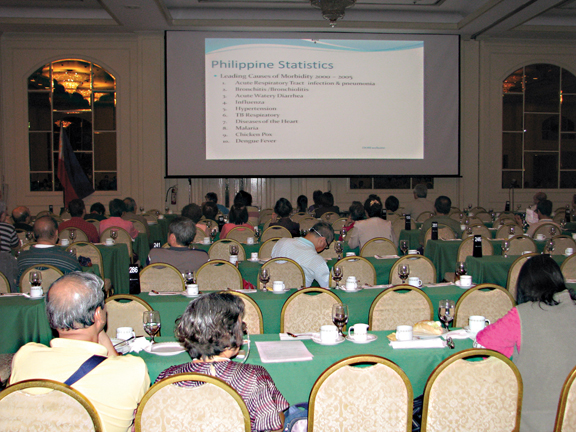Topic: Prevent Diabetes, Hypertension and Cancer Through Nutrition
DISCUSSANT: Virgith B. Buena, RND
A Healthy diet is instrumental to maintaining and/or improving general health. It requires a consumption of appropriate amounts of all essential nutrients and adequate amount of water. There should be a balance of macronutrients (carbohydrates, protein, fats) and micronutrients (vitamins and minerals). Nutrition and calories should not exceed the total energy needs for the day in order to avoid excessive weight.
A healthy diet lowers health risks such as obesity, diabetes, heart diseases, hypertension, and cancer and delays aging.
A recommended diet has the following guidelines:
- Eat Smart: learn to make healthy food choices considering the three principles of variety, balance, and moderation in your selection of food.
- Stick to regular mealtimes.
- Maintain healthy weight: control serving portions and exercise.
- Increase intake of fruits, vegetables, legumes, whole grains and nuts. These will also help increase fiber intake.
- Emphasize foods rich in nutrients, low fat, cholesterol- and-calorie free foods.
- Limit the intake of granulated sugar and other sweets.
- Cut down on salt / sodium consumption from all sources.
- Drink at least 6 to 8 glasses of water daily.
- Prepare and store foods safely.
Reading food labels or Nutrition Fact Sheet gives a good tip on amount of food and ingredients consumed.
- Get the number of grams and divide by 5, because 1 teaspoon is 5 g.
- Below 140 mg sodium is considered as low sodium.
Sleep is instrumental to good health and weight loss.
- Sleep loss upsets the balance of hormones and metabolic processes resulting in all kinds of harmful effects.
- It can cause weight gain by increasing Ghrelin, the hormone that stimulates appetite.
- It may lead to Type 2 Diabetes, by influencing the way the body slowly processes glucose.
- It may elevate blood pressure.
- It has been linked to depression, anxiety and mental disease.
- It lowers the immune system and the body’s fighting infection mechanism.
- Sleep debt is corrected with more number of hours sleep.
Medical Forum No. 236
Topic: Pneumonia
DISCUSSANT: Dennis Teo, M.D.
Pneumonia is an inflammatory condition of the lungs caused by infection either through bacteria, fungi, mycobacteria, parasites, or viruses. It affects the old and the young alike and enters the lungs through inhalation.
The general classifications of pneumonia include:
- Community acquired pneumonia
- Pneumonia in the elderly
- Non-resolving pneumonia n Nosocomial pneumonia: develops after 3 days of hospitalization
- Health care associated pneumonia
- Pneumonia in the immunocompromised
Risk factors are present in people with comorbid illnesses and patients above 65 years old. These comorbid illnesses include heart failure, COPD/Emphysema/significant smoking history, uncontrolled diabetes, and immunocompromised patients with HIV or in post-transplants persons. Other factors include exposure in an environment with increased propensity for infection, inhaled chemicals, frequent travel, prolonged hospital stay, recent surgery or injury.
Symptoms may be one or all of the following: cough, fever, tachypnea, pleuritic chest pain, abdominal pain, difficulty of breathing, body weakness, Increase or decrease in WBC, hypoxemia.
Diagnosis requires:
- Medical history and Physical examination (Chest wall retractions, crackles, rhonchi)
- Blood culture and sensitivity, or blood antibody studies: for Mycoplasma
- Sputum exam for culture and sensitivity
- Chest x-ray, Chest CT-scan, Bronchoscopy
- Viral studies, Gram and AFB Stain, Urine antigens test: for Legionella
For Community acquired pneumonia, such as acute pulmonary parenchymal infection, mild cases are treated with oral antibiotics (antibiograms) while moderate and high risk community acquired pneumonia is treated with a combination of antibiotics and intravenous medications, stabilization of the blood pressure with intravenous fluids, blood transfusion and inotropic medications and/or hooking to mechanical ventilator.
Those who suffer from symptoms may also have Indications for hospitalization if the following are present:
- Underlying comorbid conditions that can worsen pneumonia
- Failure of treatment of medications during out patient
- Signs of dehydration or inability to feed, hypotension
- Complications such as effusion / empyema
- Moderate to severe respiratory distress
- Suspicion or confirmation of a virulent pathogen
- Changes in sensorium
- Signs of sepsis
- Hypoxemia
Prevention is always better to observe. Some preventive measures are:
- Avoid people who have respiratory infections
- Strict handwashing for healthcare providers
- Flu and pneumococcal vaccination
- Gastrostomy tube insertion, if oral feeding is not possible
- Stop smoking
- Aspiration precautions
- Rehabilitation/Ambulation
Medical Forum No. 237
Topic: Current Updates and Management of Macular
Eye Diseases
DISCUSSANT: Jocelyn L. Sy, M.D.
Retina is the film portion and light-sensitive tissue that gathers visual information and transmits it to the brain which processes it for the person to understand. Macula is the most important and central portion of the retina. It is responsible for almost 90% of our vision and enables us to perceive colors, read and see fine details.
Symptoms of Macular Eye Diseases include distorted or blurred central vision, gray spot, difficulty reading despite wearing glasses.
Eye conditions that affect the macula are:
- Central Serous Retinopathy: leakage of fluid under the retina that has a propensity to accumulate under the central macula.
- Causes: stress, high blood pressure, high level of cortisol and intake of corticosteroids, Gastritis Helicobacter pylori infection
- Test Procedures: Fundus exam, Fluorescein angiogram, Ocular coherence tomography
- Treatment Options: Topical Non steroidal anti-inflammatory, Laser photocoagulation
- Macular Hole: a small break in the macula, when Vitreous, which is firmly attached to the retina, pulls away and tears the retina.
- Test Procedures: Fundus exam, Ocular coherence tomography
- Treatment Options: Eye surgery (Vitrectomy with gas tamponade)
- Macular Edema: seen in patients with diabetes, uncontrolled hypertension, after cataract surgery and inflammation of the eye. It occurs when fluid and protein deposits collect on or under the macula.
- Test Procedures: Fundus exam, Fluorescein angiogram, Ocular coherence tomography
- Treatment Options: Topical Non steroidal anti-inflammatory, Laser photocoagulation, Eye injection of Anti Vascular Endothelial Growth Factor.
- Age Related Macular Degeneration: usually affects older adults and results in a loss of vision in the macula, because of damage to the retina.
- Types: Dry, which results in thinning, loss of retinal function and rod and cone cells; Wet:, which creates new blood vessels in the choroid layer of the eye
- Causes: ultra violet radiation, hypoxia (poor supply of oxygen), oxidative stress, hereditary
- Test Procedures: Fundus exam, Fluorescein angiogram, Ocular coherence tomography
- Treatment Options: Vitamin supplements for AREDS, Topical Non steroidal anti-inflammatory, Laser photo-coagulation, Eye injection of Anti Vascular Endothelial Growth Factor.
Medical Forum No. 238
Topic: Skin Lighteners—Facts and Fiction
DISCUSSANT: Eleanor Lo Letran, M.D.
Pigmentary disorders are common with Asian skin. Everyday, consumers are seeking ways to “whiten” themselves and get rid of these skin marks. We are barraged with advertisement as well as massive proliferation of “bleaching/ whitening/ lightening” creams in the market claiming to be the best whitener. Here are some facts.
Commonly Prescribed Lighteners:
Hydroquinone, Glycolic Acid, Azelaic acid, Mequinol, Retinoids: Retinoic acid / Tazarotene
Ingredients functioning as skin lighteners found in cosmeceuticals:
Arbutin, P-Coumaric, α- Arbutin, N-Acetyl Glucosamine (NAG), Deoxyarbutin, 4-n-butylresorcinol/ rucinol, Aloesin, Gentistic acid, Resveratrol, Linoleic acid, Glabirdin, Genistein, Liquirtin, Daidzein, Soymilk / bean extract, Octadecenedoic acid, Niacinamide, Gigawhite, Glycolic Acid, Alpha lipoic acid, Rumex extract, Thiatic acid, Mulberry, Vitamin E – d-alpha tocopherol, Procyanidins, Vitamin C (Magnesium Ascorbyl Phosphate), Ellagic acid, Glutathione, 18 α G, L-alanine / glycine / L-isoleucine / L-leucine, Sophorcarpidine, Kojic Acid, Hesperidine, Retinol.
Medical Forum No. 239
Topic: Minimally Invasive Surgery of Shoulder Problems
DISCUSSANT: Raymond Nuñez, M.D.
The shoulder is the most mobile joint in the body and does the very delicate work of balancing stability and mobility.
Shoulder dislocation is the tear of the main stabilizing ligament, and is common among young active persons. The condition has a recurrence rate of 70% to 90%.
Complications resulting from shoulder dislocation include fractures of the socket, completely torn ligament, and severe deformity of the shoulder ball.
To start treatment, imaging is necessary either through E-ray or MRI or CT Scan, the latter in preparation for operation. In treating the condition, early repair is recommended. A camera that magnifies 10 to 15 times allows surgeons to examine the whole joint through small incision holes.
Minimal Invasive Surgery (Arthroscopy) is the only way to fully evaluate the shoulder. The surgeon can see and examine front, back and inside the joint, which open surgery cannot fully see. It is important to remember that tears in the shoulder joint do not heal, and pain comes and goes because the cause remains and has a tendency to get worse. Arthroscopy’s benefits, on the other hand, leads to faster recovery and earlier return to normal activities; shorter hospital stay and rehabilitation; smaller scars; and the procedure is less painful.
Some types of shoulder conditions include:
- Labral/SLAP Tear is not a dislocation but is characterized by clicking and pain.
- Microtrauma, which is common among athletes representing overuse injuries caused by hyper external rotation, falls on arms/elbows, bad fall, or injuries from violent sports.
- Frozen Shoulder, which causes more than 50% motion loss and lasts for more than 3 months, with no other shoulder pathologies. This is common among females 40 to 60 years old with diabetes and thyroid diseases.
- Impingement Syndrome leading to Rotator Cuff Tear, which is characterized by an upward migration of the ball of the arm bone and can cause force imbalance, none functional joint, and muscle shortening. This is common among the elderly population and can also be secondary to degeneration or trauma.
- Chronic Rotator Cuff Tears, which can lead to osteoporosis of the ball and subsequent structural changes.
- AC Joint Arthritis, where painful bone spur formation between the acromion and collarbone is present. This is usually seen among heavy manual laborers, weightlifters, and patients who suffered from fractures/dislocations of the collarbone.
- Shoulder Arthritis, which is a loss of cartilage in the shoulder and characterized by pain and morning stiffness. This is common among heavy manual laborers and those who have suffered from fractures in the shoulder.
Treatment options for different shoulder conditions include:
- Arthroscopy (Minimal Invasive Surgery) for Labral/SLAP Tear and Microtrauma
- Physical Therapy and steroids for Frozen Shoulder
- Surgery to create more space, rehabilitation, minimal invasive surgery for Impingement Syndrome
- Reverse Shoulder Replacement for irreparable chronic cuff tear.


 RSS Feed
RSS Feed